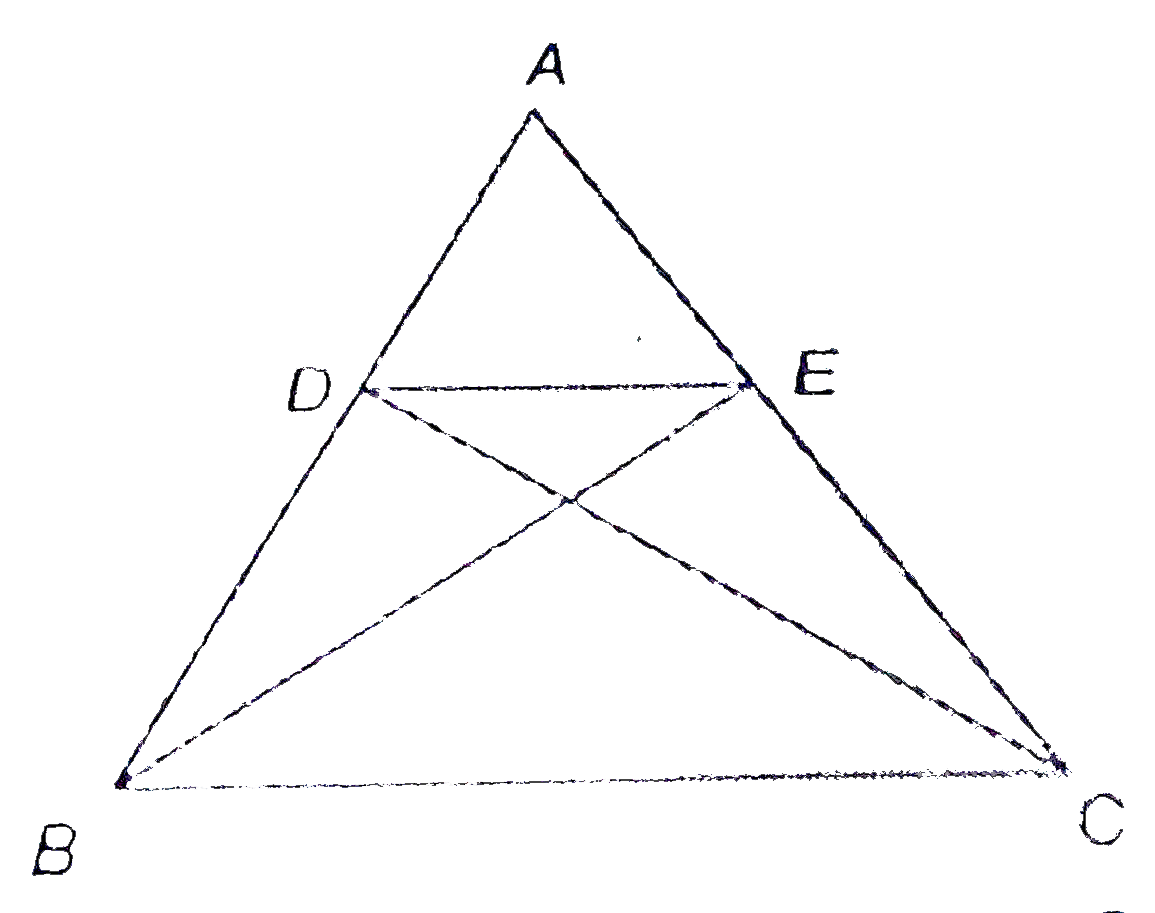In a are the mid-points of respectively. If O is the circumcentre of the then the value of equal to
The correct Answer is:4
To solve the problem, we need to find the value of Area of ΔABCArea of ΔOPQ⋅cotB⋅cotC.
Step 1: Identify the areas of the triangles
1. Area of Triangle ABC:
The area of triangle ABC can be expressed using the formula:
AreaABC=12⋅AB⋅AC⋅sinC
We can also express this in terms of the circumradius R:
AreaABC=abc4R
where a=BC, b=AC, and c=AB.
2. Area of Triangle OPQ:
Since P and Q are midpoints of AB and AC, respectively, the segment PQ is parallel to BC and half its length:
PQ=12BC=a2
The height from O to PQ can be calculated using the circumradius R and the angles:
OQ=RcosB
The angle PQO is 90∘−C, thus:
AreaOPQ=12⋅PQ⋅OQ⋅sin(PQO)=12⋅a2⋅RcosB⋅sin(90∘−C)=12⋅a2⋅RcosB⋅cosC
Simplifying this gives:
AreaOPQ=aR4cosBcosC
Step 2: Calculate the ratio of the areas
Now we can find the ratio of the areas:
AreaABCAreaOPQ=abc4RaR4cosBcosC
This simplifies to:
abc4R⋅4aRcosBcosC=bcR2cosBcosC
Step 3: Multiply by cotBcotC
Now we multiply this ratio by cotBcotC:
bcR2cosBcosC⋅cotBcotC=bcR2cosBcosC⋅cosBcosCsinBsinC=bcR2sinBsinC
Step 4: Final simplification
Using the relationship R=abc4AreaABC, we can substitute and simplify:
bc(abc4AreaABC)2sinBsinC=4Area2ABCa2sinBsinC
Conclusion
After evaluating the above expressions, we find that:
AreaABCAreaOPQ⋅cotB⋅cotC=4
Thus, the final answer is:
4
1. Area of Triangle ABC:
The area of triangle ABC can be expressed using the formula:
AreaABC=12⋅AB⋅AC⋅sinC
We can also express this in terms of the circumradius R:
AreaABC=abc4R
where a=BC, b=AC, and c=AB.
Since P and Q are midpoints of AB and AC, respectively, the segment PQ is parallel to BC and half its length:
PQ=12BC=a2
The height from O to PQ can be calculated using the circumradius R and the angles:
OQ=RcosB
The angle PQO is 90∘−C, thus:
AreaOPQ=12⋅PQ⋅OQ⋅sin(PQO)=12⋅a2⋅RcosB⋅sin(90∘−C)=12⋅a2⋅RcosB⋅cosC
Simplifying this gives:
AreaOPQ=aR4cosBcosC
Now we can find the ratio of the areas:
AreaABCAreaOPQ=abc4RaR4cosBcosC
This simplifies to:
abc4R⋅4aRcosBcosC=bcR2cosBcosC
Now we multiply this ratio by cotBcotC:
bcR2cosBcosC⋅cotBcotC=bcR2cosBcosC⋅cosBcosCsinBsinC=bcR2sinBsinC
Using the relationship R=abc4AreaABC, we can substitute and simplify:
bc(abc4AreaABC)2sinBsinC=4Area2ABCa2sinBsinC
After evaluating the above expressions, we find that:
AreaABCAreaOPQ⋅cotB⋅cotC=4
4
Topper's Solved these Questions
- BOOK - ARIHANT MATHS ENGLISHCHAPTER - PROPERTIES AND SOLUTION OF TRIANGLES EXERCISE - PROPERTIES AND SOLUTIONS OF TRIANGLES EXERCISE 6 : SINGLE INTEGER ANSWER TYPE QUESTIONS1videos
PROPERTIES AND SOLUTION OF TRIANGLES
- BOOK - ARIHANT MATHS ENGLISHCHAPTER - PROPERTIES AND SOLUTION OF TRIANGLES EXERCISE - Exercise (Subjective Type Questions)21videos
PROPERTIES AND SOLUTION OF TRIANGLES
- BOOK - ARIHANT MATHS ENGLISHCHAPTER - PROPERTIES AND SOLUTION OF TRIANGLES EXERCISE - PROPERTIES AND SOLUTIONS OF TRIANGLES EXERCISE 5: MATCHING TYPE QUESTIONS3videos
PROPERTIES AND SOLUTION OF TRIANGLES
- BOOK - ARIHANT MATHS ENGLISHCHAPTER - PRODUCT OF VECTORSEXERCISE - Exercise (Questions Asked In Previous 13 Years Exam)51videos
PRODUCT OF VECTORS
- BOOK - ARIHANT MATHS ENGLISHCHAPTER - SEQUENCES AND SERIESEXERCISE - Exercise (Questions Asked In Previous 13 Years Exam)38videos
SEQUENCES AND SERIES
Similar Questions
In a ΔABC,D,EandF are the mid-point of sides BC, CA and AB respectively. If area of ΔABC=16cm2, find the area of trapezium FBCE
View SolutionD, E and F are the mid-points of the sides BC, CA and AB respectively of triangle ABC. Prove that:
area of BDEF is half the area of ΔABC.View SolutionIf D, E, F are respectively the mid-points of AB, AC and BC respectively in a ΔABC, then −−→BE+−−→AF=
View SolutionG is the centroid of triangle ABC and A1 and B1 are the midpoints of sides AB and AC, respectively. If Δ1 is the area of quadrilateral GA1AB1 and Δ is the area of triangle ABC, then ΔΔ1 is equal to
View SolutionG is the centroid of triangle ABC and A1 and B1 are the midpoints of sides AB and AC, respectively. If Δ1 is the area of quadrilateral GA1AB1 and Δ is the area of triangle ABC, then ΔΔ1 is equal to
View SolutionA line PQ is drawn parallel to the base BC of ΔABC which meets sides AB and AC at points P and Q respectively. If AP=13PB, find the value of :
Area of ΔABCArea of ΔAPQView SolutionThe medians of ΔABC intersect at point G. Prove that:
area of ΔAGB=13× area of ΔABCView SolutionFind the value of tan A, if area of ΔABCisa2−(b−c)2.
View SolutionIn the given triangle P, Q and R are the mid points of sides AB, BC and AC respectively. Prove that triangle PQR is similar to triangle ABC.
 View Solution
View SolutionIn the adjoning figure, D and E are the points on the sides AB and AC respectively of ΔABC and area of ΔBCE= area of ΔBCD.
Prove that DE∣∣BC
 View Solution
View Solution

